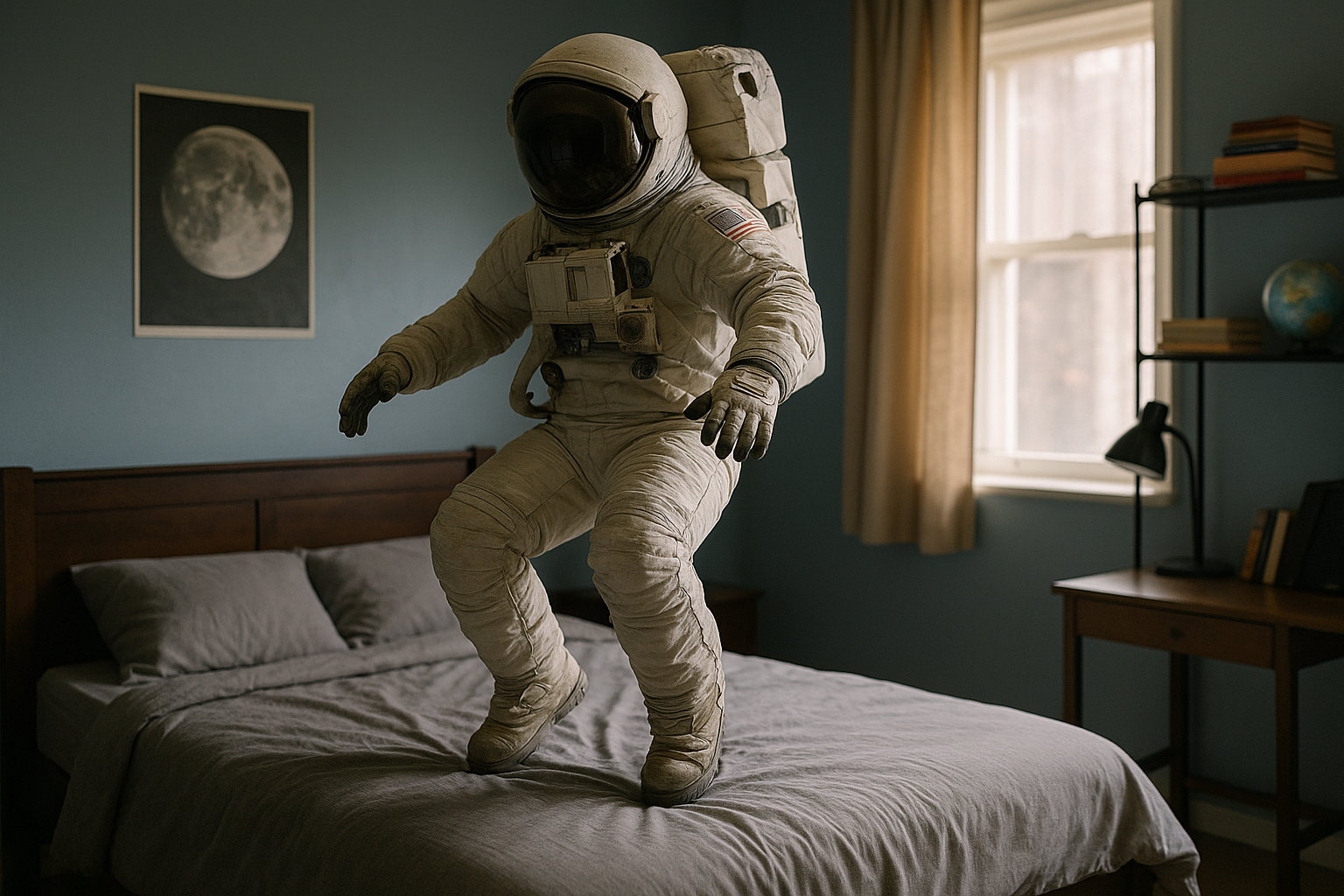Picture this: you suddenly awaken from an intense dream, your consciousness slowly returning, but something feels terrifyingly wrong. Your eyes flutter open, you recognize your familiar surroundings, yet your body refuses to respond. You’re completely paralyzed after a dream, trapped between the world of sleep and wakefulness.
This frightening experience isn’t supernatural—it’s sleep paralysis, a fascinating yet disturbing neurological phenomenon that affects millions worldwide. Understanding what happens when you experience sleep paralysis after dreaming can help you regain control over these unsettling episodes.
🌙 Want to track your dream patterns and sleep disturbances? Discover comprehensive analysis with the Dreamly App – your personal sleep and dream companion.
What Is Sleep Paralysis? The Science Behind the Terror
Sleep paralysis occurs when your mind regains consciousness while your body remains in the natural muscle atonia (temporary paralysis) that happens during REM sleep. This protective mechanism normally prevents you from physically acting out your dreams, but sometimes the timing goes awry.
During a typical sleep cycle, your brain carefully orchestrates the transition between sleep stages. However, when you experience sleep paralysis after a dream, this delicate process becomes disrupted, leaving you conscious but unable to move, speak, or even breathe normally.
The Dream-Paralysis Connection: Why It Happens After Vivid Dreams
The link between intense dreams and subsequent paralysis isn’t coincidental. When you wake directly from emotionally charged or extremely vivid dreams, your brain struggles to make a clean transition from the dream state to full wakefulness.
Several factors make sleep paralysis after dreaming more likely:
1. Emotional Dream Intensity
High-stress, frightening, or emotionally overwhelming dreams create neurochemical changes that can interfere with the normal wake-up process, causing consciousness to return while muscle paralysis persists.
2. REM Sleep Disruption
Abrupt awakenings from deep REM sleep—where the most vivid dreams occur—increase the chances of experiencing paralysis as your brain hasn’t completed its natural transition sequence.
3. Lingering Dream Content
When dream imagery remains active in your newly conscious mind, it can blend with reality, creating the hallucinations commonly associated with sleep paralysis episodes.
4. Stress and Anxiety Amplification
Dreams that process daily stress or anxiety can leave your nervous system in a heightened state, making smooth sleep transitions more difficult.
Types of Sleep Paralysis: Understanding Different Experiences
Isolated Sleep Paralysis
This occurs in otherwise healthy individuals and is often triggered by specific circumstances like stress, sleep deprivation, or irregular sleep schedules. Episodes are typically infrequent and manageable.
Recurrent Sleep Paralysis
Some people experience regular episodes, often linked to underlying sleep disorders, chronic stress, or genetic predisposition. These require more comprehensive management strategies.
Sleep Paralysis with Hallucinations
The most frightening type involves vivid visual, auditory, or tactile hallucinations. These occur because your brain is still partially in dream mode while you’re conscious.
Common Hallucinations During Sleep Paralysis Episodes
The hallucinations experienced during sleep paralysis fall into three main categories, each with distinct characteristics:
Intruder Hallucinations
Sensing a malevolent presence in the room, seeing shadowy figures, or hearing footsteps and voices. These often feel like extensions of nightmare content from recent dreams.
Incubus Hallucinations
Feeling pressure on the chest, difficulty breathing, or sensations of being choked or suffocated. Many describe feeling like something is sitting on their chest.
Vestibular-Motor Hallucinations
Sensations of floating, flying, falling, or out-of-body experiences. These often connect to dream content involving movement or spatial disorientation.
Cultural and Historical Perspectives on Sleep Paralysis
Throughout history, cultures worldwide have developed explanations for sleep paralysis experiences:
The “Old Hag” in Anglo-Saxon folklore, “Pinyin” in China, “Karabasan” in Turkey, and “Se me subió el muerto” in Mexico all describe remarkably similar experiences. These cultural interpretations highlight how universal and impactful sleep paralysis after dreaming has been across human societies.
Who Is Most Susceptible to Sleep Paralysis?
While anyone can experience sleep paralysis, certain groups face higher risks:
High-Risk Demographics
Teenagers and young adults (peak occurrence between ages 14-25), people with irregular work schedules, students under academic stress, and individuals with anxiety disorders show increased susceptibility.
Sleep-Related Risk Factors
Chronic sleep deprivation, frequent lucid dreaming, narcolepsy, sleep apnea, and bipolar disorder significantly increase the likelihood of experiencing episodes.
Lifestyle and Environmental Triggers
High caffeine consumption, sleeping on your back, jet lag, major life changes, and chronic stress can all trigger sleep paralysis after intense dreams.
The Psychological Impact: Beyond the Physical Experience
While physically harmless, sleep paralysis can have significant psychological effects:
Many people develop sleep anxiety, fearing bedtime due to potential episodes. This can create a cycle where anxiety about sleep paralysis actually increases its likelihood. The vivid, frightening nature of these experiences often leaves lasting impressions that can affect sleep quality and mental health.
Prevention Strategies: Reducing Sleep Paralysis Episodes
Sleep Hygiene Optimization
Maintaining consistent sleep schedules, creating a relaxing bedtime routine, keeping your bedroom cool and dark, and avoiding screens before bed can significantly reduce episodes.
Stress Management Techniques
Regular meditation, progressive muscle relaxation, journaling to process daily stress, and addressing underlying anxiety through therapy or counseling can help prevent stress-induced episodes.
Dietary and Lifestyle Modifications
Limiting caffeine intake, especially in the afternoon, avoiding heavy meals before bedtime, reducing alcohol consumption, and maintaining regular exercise can improve overall sleep quality.
Sleep Position Awareness
Many people find that sleeping on their side rather than their back reduces the frequency of sleep paralysis episodes. This position change can improve breathing and reduce the likelihood of REM sleep disruption.
What to Do During a Sleep Paralysis Episode
If you find yourself experiencing sleep paralysis after a dream, these techniques can help:
Stay Calm and Recognize the Experience
Remind yourself that this is temporary and not dangerous. Understanding that you’re experiencing sleep paralysis can reduce panic and make the episode shorter.
Focus on Small Movements
Try to move your fingers, toes, or facial muscles. These smaller muscle groups may respond first and can help break the paralysis.
Concentrate on Breathing
While breathing may feel labored, focus on slow, controlled breaths. This can help calm your nervous system and facilitate the transition to full wakefulness.
Mental Techniques
Some people find that mentally “fighting” the paralysis or trying to call out can help break the episode. Others prefer visualization techniques or reciting familiar phrases.
When to Seek Professional Help
Consider consulting a healthcare provider if:
- Episodes occur multiple times per month and significantly impact your sleep quality or daily functioning
- You develop chronic sleep anxiety or insomnia due to fear of sleep paralysis
- Episodes are accompanied by other concerning symptoms like excessive daytime sleepiness or sudden muscle weakness
- You suspect an underlying sleep disorder like narcolepsy or sleep apnea
- The psychological impact affects your mental health, relationships, or work performance
- Use the Dreamly App to track patterns and share detailed episode logs with your healthcare provider
Treatment Options and Medical Interventions
For frequent or severe cases, medical treatment may include:
Medication Options
Antidepressants can help regulate REM sleep cycles, while anxiety medications may reduce stress-related triggers. Sleep specialists might prescribe specific medications to improve sleep quality.
Cognitive Behavioral Therapy
CBT can help address sleep anxiety, develop coping strategies, and improve overall sleep hygiene. This approach is particularly effective for managing the psychological aspects of recurrent episodes.
Sleep Study Evaluation
Comprehensive sleep studies can identify underlying sleep disorders that may be contributing to frequent sleep paralysis episodes, allowing for targeted treatment.
Living with Sleep Paralysis: Long-term Management
For those who experience recurring episodes, developing a comprehensive management plan is crucial:
Creating a support network of understanding family and friends, maintaining detailed sleep and episode logs, developing personalized coping strategies, and staying informed about new research and treatment options can all contribute to better long-term outcomes.
Remember that sleep paralysis after dreaming is a manageable condition. With proper understanding, prevention strategies, and professional support when needed, you can reduce the frequency and impact of these episodes on your life.
The Silver Lining: Understanding Brings Control
While sleep paralysis can be terrifying, knowledge is power. Understanding that these episodes are temporary, not dangerous, and often manageable can significantly reduce their psychological impact.
Many people find that once they understand the science behind sleep paralysis, the experiences become less frightening. Some even learn to recognize the onset of episodes and develop personal techniques for managing them effectively.
You’re not alone in this experience, and with the right approach, you can reclaim peaceful, restorative sleep.






